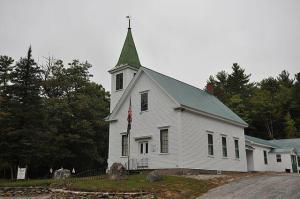Albany NH is a town in Carroll County, New Hampshire, United States. The population was 759 at the 2020 census. Most of Albany is within the southeastern corner of the White Mountain National Forest, including Mount Chocorua and Mount Paugus.Wikipedia
Search New Hampshire Here


Albany NH is a town in Carroll County, New Hampshire, United States. The population was 759 at the 2020 census.[2]
Most of Albany NH is within the southeastern corner of the White Mountain National Forest, including Mount Chocorua and Mount Paugus. Albany is the entrance to the Mount Washington Valley, and features a 120-foot (37 m) covered bridge that spans the Swift River just north of the Kancamagus Highway. Albany is also home to the World Fellowship Center, an intergenerational camp and conference retreat center founded in 1941 by and for peace activists.[3]
History - Albany NH
The community was first chartered in 1766 by colonial Governor Benning Wentworth as "Burton", for General Jonathan Burton of Wilton, New Hampshire. Albany NH was incorporated and renamed "Albany" in 1833, when the New York Central Railroad from New York City to Albany, New York, was chartered.
Geography - Albany NH
According to the United States Census Bureau, Albany NH has a total area of 75.8 square miles (196.2 km2), of which 75.1 square miles (194.6 km2) are land and 0.58 square miles (1.5 km2) are water, comprising 0.79% of the town.[1] It is drained by the Swift River in the north and the Chocorua River in the south. The town lies fully within the Saco River watershed.[4] Mount Chocorua, the highest point in Albany, has an elevation of 3,474 feet (1,059 m), and Mount Paugus has an elevation of 3,201 ft (976 m).
85% of the area of Albany NH is part of the White Mountain National Forest.[5] Most residential development occurs in the southeastern portion of the town, along New Hampshire Route 16. Route 112, the Kancamagus Highway, runs east-west along the Swift River and is nearly entirely within the national forest. The former village of Passaconaway occupies a broad valley along the Kancamagus Highway in the northwestern part of the town. The area is now a national forest visitor attraction. Other place names within the town limits include Ferncroft, in the extreme southwest corner of town, and the former site of Paugus Mill, along the town's southern boundary.
Demographics Albany NH
| Census | Pop. | Note | %± |
|---|---|---|---|
| 1840 | 406 | — | |
| 1850 | 455 | 12.1% | |
| 1860 | 430 | −5.5% | |
| 1870 | 339 | −21.2% | |
| 1880 | 361 | 6.5% | |
| 1890 | 377 | 4.4% | |
| 1900 | 210 | −44.3% | |
| 1910 | 289 | 37.6% | |
| 1920 | 170 | −41.2% | |
| 1930 | 96 | −43.5% | |
| 1940 | 131 | 36.5% | |
| 1950 | 154 | 17.6% | |
| 1960 | 146 | −5.2% | |
| 1970 | 259 | 77.4% | |
| 1980 | 383 | 47.9% | |
| 1990 | 536 | 39.9% | |
| 2000 | 654 | 22.0% | |
| 2010 | 735 | 12.4% | |
| 2020 | 759 | 3.3% | |
| U.S. Decennial Census[2][6] | |||
As of the census[7] of 2000, there were 654 people, 262 households, and 182 families residing in the town. The population density was 8.7 people per square mile (3.4/km2). There were 506 housing units at an average density of 6.8 per square mile (2.6/km2). The racial makeup of the town was 98.47% White, 0.15% African American, 0.31% Native American, 0.15% Asian, 0.31% Pacific Islander, and 0.61% from two or more races. Hispanic or Latino of any race were 0.76% of the population.
There were 262 households, out of which 34.7% had children under the age of 18 living with them, 51.5% were married couples living together, 10.7% had a female householder with no husband present, and 30.2% were non-families. 23.3% of all households were made up of individuals, and 7.3% had someone living alone who was 65 years of age or older. The average household size was 2.48 and the average family size was 2.85.
In the town, the population was spread out, with 26.5% under the age of 18, 6.1% from 18 to 24, 36.7% from 25 to 44, 22.8% from 45 to 64, and 8.0% who were 65 years of age or older. The median age was 37 years. For every 100 females, there were 100.6 males. For every 100 females age 18 and over, there were 102.1 males.
The median income for a household in the town was $36,635, and the median income for a family was $39,250. Males had a median income of $29,821 versus $20,250 for females. The per capita income for the town was $20,690. About 10.8% of families and 15.7% of the population were below the poverty line, including 23.9% of those under age 18 and 4.3% of those age 65 or over.